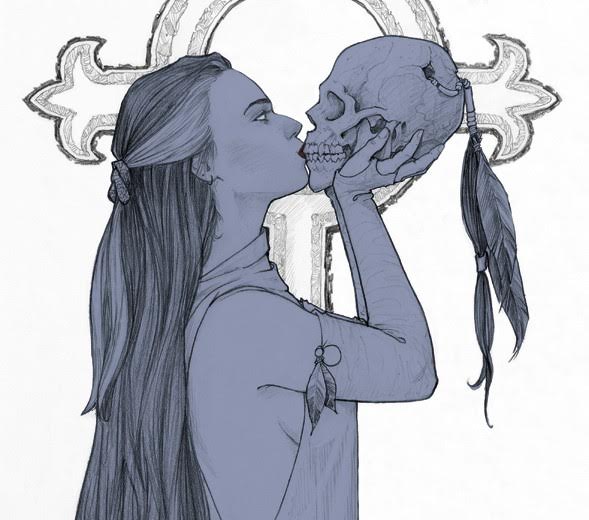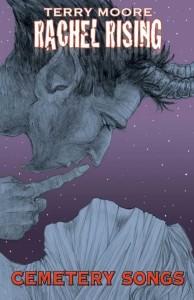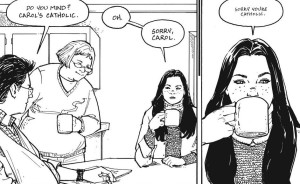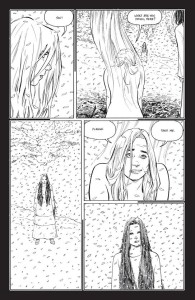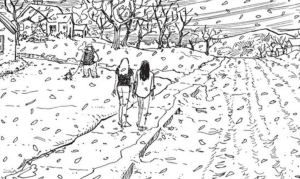Writer and artist Terry Moore of Abstract Studio was interviewed by PREVIEWSworld.com during the 2013 San Diego Comic Con to discuss the progression of the series and the release of the new trade, Rachel Rising – Cemetery Songs. During the interview, he talks about the romanticism of Strangers in Paradise and how the world has changed. Writing the series with a lot more grit, the author puts, “but it’s still me doing it” is an understatement. Writing with strong female characters managing through a chaotic world, he’s still able to insert his comic relief and make them beautiful in the afterlife. Rachel Rising has influences of Hitchcock and other horror films, Moore’s goal was to “creep people out.”
There was also a brief moment of discussion for starting a television series based on the comic. An interview earlier this year with ComicBook.com, he stated that now the convention season is over, “I’m writing the pilot for the Rachel Rising TV Show.” Personally, this makes me nervous. Without any doubt, I would love to see this show brought to life, but I hope that it won’t stray too far away from the series as other comic book-turned-shows have. If I had the opportunity to work on the film during its production process, it would be a dream job for me as a filmmaker! As a side note, watching a script “come alive” during the production and post-production phases is some beautiful kind of magick.
Spoiler-Free Summary
“Somebody calling
Calling my name;
Somebody walking
Over my grave.”
– Robin Trower
These lyrics displayed in Issue #18 of Rachel Rising are derived from Robin Trower’s “Somebody Calling” from his album In City Dreams (1977). How perfectly suited for this trade.
Rachel Rising – Cemetery Songs is the third volume in the trade format continuing from Fear No Malus. Fear No Malus, Malus informed Zoe of his plan now that she is able to grow-up from being a child for the past fifty years; Rachel learning of Lilith’s past—as well as her own—history and the fate she has in store for Manson; and Jet was electrocuted under Malus’ control to take hold of a new body in General Manson Hospital’s chapel. The chapel is often referred to throughout Cemetery Songs and creates controversy amongst popular characters.
Cemetery Songs encompasses issues thirteen to eighteen, leaving readers with an uncomfortable cliff-hanger at the end. In this volume, we witness new flashback scenes featuring Johnny and Carol, Malus’ “old friend,” and a story as told by Dr. Siemen to, of his version of Sleeping Beauty in the beginning of Issue #13.
The following issues focus more on discovering the scientific reasoning of Rachel, Jet, and the other womyn murdered are still walking around and the destruction of Manson one faucet at a time.
My favorite metaphor in this book is featured in Issue #17, as a cat stands on a tree branch as a rat looks down at it, along with Rachel’s commentary on Zoe’s history:
Looks are deceiving, Jet. Zoe looks like a little girl, but inside she’s old and filled with the deaths of other people. People she’s killed.
Familiar with Moore’s style, he inserts comic relief and controversial remarks throughout this work. The most “offensive” one I’ve seen thus far in the series is when Jet comments on Carol’s choice of beliefs of being Catholic. As stated earlier, the chapel scene in which Jet is electrocuted is crucial for setting up the current story arcs featured in this trade. Jet does not recall of any what happened during the time Malus took over her body—as we learned from Fear No Malus—and Moore does not hide the intention that it is okay to believe in different forms of faith, but to also be mindful. It’s his characters and he can do whatever the f*ck he wants in terms of making them gentle beings, like Julie Martin in Echo, or deranged psychopaths, like some of the characters featured in this series. That is for the reader to decide, of course.
More Historical Contexts (Some Spoilers)
Mankind is a summer field, barren, dry and fallow.” –Lilith
In my last review, I discussed the historical context of the character “Lilith” and The Zohar. To recap, according to the books within The Zohar, Lilith was the first wife of Adam. In the following issues, Moore dives further into the history of Lilith and her role within his universe—as much as it is ours.
Issues sixteen through eighteen displays numerous simplistic-illustrated panels of Lilith’s self-burning sacrifice in the middle of the woods with two of her followers, Natalie Chase and Lindy Ball. In Issue #17 before Lilith reincarnates from the ashes, two hunters approach the womyn as heavy snow continues to fall, while only wearing thin cloaks to cover themselves.
The two hunters demand that the two womyn tell them why they’re performing a “séance,” all the while calling them titty-girl(s). The wolves—whom we learn are officially under their control—devour the men as an act of protection and a meal-ticket. At this point, Lilith “rises” (kneels in the fire pit) and a womyn in the distance appears. The womyn looks like a less terrifying version of the little girl in The Ring, to ignore Lilith’s questions and pleas as she takes to two men from separate places. By the end, we learn that she is Ma Malai, the Angel of Death, and is forbidden to talk to Lilith. Ma Malai was featured in the dreams of Molly Lane in Strangers in Paradise.
As written in Echo, Moore follows the same trivial suit with religious characters. Forth going, I’m eagerly curious to see if the womyn will come face to face again. As an ending note, Lilith states despairingly to Natalie and Lindy,
He’s punishing me. He’s punishing me for hating her…Eve. Leaving me here forever with the remains of her filthy seed. She gets heaven, I get this stinking planet. There will never be peace while her children breed like bacteria. Not with me here.
There’s nothing we can do about that, Lilith. (One of the womyn replies.)
Yes, there is. We kill them… every last one of them. Send them back to her, en masse. Starting with Manson.
On the other hand, we only see Dr. Siemen for a few brief moments in the beginning of the book with Earl. He’s such a creep. The two are at the morgue where they stand over Jet’s corpse and discussion about the origin of fairy tales. It’s clear of this point in the story that Earl loves Jet and Dr. Siemen is insinuating that Earl takes advantage of Jet—look at his life. It’s a whole lot of icky.
The origin of this fairy tale as Dr. Siemen describes, was written in Perceforest—a compilation of six books written in the South of France between 1330 and 1344. If you do not know the Grimm Brothers story of the tale, “Sleeping Beauty” the prince rapes her while she sleeps and delivers two children while not waking.
The tale of Sleeping Beauty doesn’t freak me out, but that Moore drew two panels next to each of the sinister looks on both the monk from the story and of Dr. Siemen. Early on in the series, we learned Dr. Siemen wants to learn the miracle of Rachel and Jet’s living-dead ability in order to wake his own wife from her slumber.
Conclusion
I read this comic during my slow periods at work and while reading, I was sighing, adding commentary, laughing, and the like and my co-workers asked me what I was implying. Every time, I responded, “It’s this story!” Moore’s goal with the Rachel Rising series was to “creep people out” and make it hard to go to sleep at night. My only disappointment was to not read this trade before going to bed.
To purchase the comic book, follow this link.
Publisher: Robyn Moore
All images used with permission of the publisher.
Full Disclosure: The reviewer received a copy of the comic for review.

